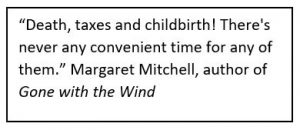On February 24, 2022, Harbor Capital, in partnership with Irrational Capital, launched the Harbor Corporate Culture ETF (HAPY). The fund invests in companies with the strongest employee-employer relationships. As the ticker implies, in firms where the employees are happy. It is a passive fund whose investment universe is Continue reading →
Category Archives: Mutual Fund Commentary
These Uncertain Times
The Federal Reserve is raising rates to slow the economy, reduce inflation, and reduce bond purchases (Quantitative Tightening). The International Monetary Fund and World Bank are lowering forecasts of global growth, and the Russian invasion of Ukraine is further disrupting supply chains and raising geopolitical tensions. I am at my neutral allocation of 50% to stocks but have shifted away from the most volatile funds and toward more defensive funds that do well during the late stage of the business cycle and higher inflation. This article describes Continue reading →
Briefly Noted . . .
 Artisan Partners launched its Artisan Global Unconstrained and Artisan Emerging Markets Debt Opportunities Funds on April 7. Michael Cirami will be the Lead Portfolio Manager while Sarah Orvin will serve as the Portfolio Manager of both funds. Both Mr. Cirami and Ms. Orvin previously worked for Eaton Vance Management.
Artisan Partners launched its Artisan Global Unconstrained and Artisan Emerging Markets Debt Opportunities Funds on April 7. Michael Cirami will be the Lead Portfolio Manager while Sarah Orvin will serve as the Portfolio Manager of both funds. Both Mr. Cirami and Ms. Orvin previously worked for Eaton Vance Management.
Charles Schwab has filed filings to offer Direct indexing, which involves direct ownership of securities and thus can involve a greater level of tax management, sometime in April. Schwab’s direct indexing will have an account minimum of $100,000 and will charge a fee of 40 basis points. Initially, investors will have access to Continue reading →
April 1, 2022
Dear friends,
Spring is a time when we celebrate the small and uncertain signs of hope. Weighed down by the exhaustion of war and politics, pandemic and winter, we look happily at the first crocus to spring which shoulders its way through the autumnal leaf mold. We’re reluctant to invest too much in it, knowing that winter has not yet suffered its final defeat. (Here, anyway. Last Wednesday’s upper 60s was followed by Thursday’s measurable snow.) Continue reading →
Recipe-based investing
Step One: Find the right recipe.
Indexes are recipes. By that, I mean they’re really precise sets of instructions that direct you in what ingredients, in what amounts, need to be treated, in what way to achieve a particular, predictable outcome. In investing, as in cooking, recipes are relatively recent inventions. Once upon a time, both activities were dominated by the notion that “experienced old guys do their thing, the rest of us watch in awe.”
Take luce or tench or fresh haddock, & boil them & fry them in olive oil. And then take vinegar and the third part sugar & onions minced small, & boil all together, & mace & cloves & cubeb. And lay the fish in dishes & pour the sauce above & serve it forth. Continue reading →
On Active vs Passive Equity Mutual Funds
When I came across a quote by Peter Lynch on how passive fund investors were making a mistake, I had two choices: to sweep his comments under the rug or evaluate the validity of them. In the article below, we will look at:
-
- Lynch’s argument
- My researched reasons for preferring passive investing.
- The role of confirmation bias and how it can hurt or help investors.
- The results of a careful analysis of the performance of Mr. Lynch’s preferred funds
- Finally, a few conclusions.
The takeaway: Outperforming MFs do exist but their taxable distributions are a larger drag than expected.
We’re inviting you to Continue reading →
Two cheers for active management!
Devesh and I have an ongoing conversation about the value of active managers. He thoughtfully runs through the arguments – from consistency to tax efficiency – that led him to conclude, “not much value there.” Cool and sensible.
If you want to join the conversation but start with somewhat greater sympathy for the role of active managers, you might consider five arguments. Continue reading →
Managing Risk During Inflation
I have expressed my intention to retire in the next few months with the specter of stagflation looming. I have studied the 1960s to 1970s stagflation period since I lived through these times and know that they are secular. Federal Reserve Chairman Jerome Powell recently described the potential for inflation to last for an extended period of time:
…the risk is rising that an extended period of high inflation could push longer-term expectations uncomfortably higher, which underscores the need for the Committee to move expeditiously as I have described. (Powell Says ‘Inflation Is Much Too High’ And The Fed Will Take ‘Necessary Steps’ To Address,” CNBC, 3/21/2022) Continue reading →
Briefly Noted . . .
DoubleLine Capital, Jeffrey Gundlach’s $137bn asset management firm, has received approval from the Securities and Exchange Commission (SEC) to launch two active non-transparent ETFs.
The company initially filed for the strategies – the DoubleLine Opportunistic Bond ETF and the DoubleLine Shiller CAPE US Equities ETF – in October 2021. The funds have expense ratios of 0.5% and 0.65%, respectively.
The funds will not disclose assets Continue reading →
March 1, 2022
Dear friends,
It’s been that kind of year. Who would have guessed that I’d miss the quiet sanity of 2021?
It has been a lot like that, hasn’t it?
Here’s a snapshot of 2022 so Continue reading →
Overcoming Drawdowns
My “Thoughts on Inflation Protection” essay, which appeared in MFO’s February 2022 issue, focused primarily on the role of different major asset classes in providing an inflation buffer for your portfolio. The article was focused in particular on the performance of funds and ETFs with substantial exposure to TIPS (Treasury Inflation-Protected Securities) and similar products. I highlighted the promise of short-duration TIPS funds.
In passing, I also noted the long-term potential role of domestic stocks and Equity REITS in protecting against inflation, while mentioning their two main drawbacks. One, they do not Continue reading →
Managing Risk During Normalization and Rising Rates
Risk is defined as “the possibility of loss or injury” by the Merriam-Webster Dictionary and volatility as “a tendency to change quickly and unpredictably.”
Risk refers to the possibility of loss, which is outcome focused. Volatility refers to a quick, unpredictable change, which isn’t centered on the outcome. To be a good investor, a person must be able to differentiate between these. Volatility acts as noise, while risk is worth paying attention to.
– The Difference Between Risk And Volatility, Investopedia, Judy Hulsey
I continue to expect a regime change from mid-cycle to late-cycle later this year and look for opportunities to reduce exposure to riskier assets from my current 55%. Fourth-quarter nominal gross domestic product is up 11.8% compared to a year ago with the consumer price index up 7.5% for a real (inflation-adjusted) gross domestic product of 5.6%. Inflation, valuations, geopolitical risks, and volatility are Continue reading →
The case for a stock-light portfolio, version 4.0
Update from the MFO archive
“Stocks for the long-term!” goes the mantra. That chant has two meanings: (1) in the (very) long-term, no asset outperforms common stock. And (2) in any other term, stocks are too volatile to the trusted so if you’re going to buy them, be sure you’re doing it with a long time Continue reading →
Death, taxes and childbirth
As we head into March, it will soon be spring. A young man’s fancy lightly turns to love, while young and not so young investors’ thoughts turn more solemnly to taxes. This seems like an appropriate time to look at one corner of taxation – curiosities of ordinary income dividends distributed by funds.
 I’ve been told that some people find taxes numbingly dull and perplexing. Who could imagine? Just to help you target your attention, Continue reading →
I’ve been told that some people find taxes numbingly dull and perplexing. Who could imagine? Just to help you target your attention, Continue reading →
Briefly Noted
Updates
On February 17, the Securities and Exchange Commission charged James Velissaris, the former Chief Investment Officer and founder of Infinity Q Capital Management, with overvaluing assets by more than $1 billion while pocketing tens of millions of dollars in fees.
The SEC’s complaint alleges that, from at least 2017 through February 2021, Velissaris engaged in Continue reading →
February 1, 2022
Dear friends,
Welcome to February. It’s a month frequently associated with the color red – as in Valentine’s Day hearts, chocolate boxes, and scandalous lingerie – but investors have started the year seeing a different kind of red.
Here’s a compendium of every Vanguard index mutual fund (one share class for each) but appearances by a handful of special guests. In one month, investors had YTD returns of … Continue reading →
Thoughts on Inflation Protection
An entire generation of investors has come of age without needing to learn how to protect portfolios and their wealth from Inflation. The mantra, three or four years ago, was “inflation is dead.” When inflation finally appeared last year, the Federal Reserve Chair declared it to be merely “transitory.” Sticky and low inflation for years has permitted the Fed to keep interest rates at historically low levels – a development which some fear has underwritten federal deficits, emboldened stock speculators, and punished savers. Increasingly, it appears that Continue reading →
Analysis Paralysis and Talking Heads
“But I don’t want to go among mad people,” Alice remarked.
“Oh, you can’t help that,” said the Cat: “we’re all mad here. I’m mad. You’re mad.”
“How do you know I’m mad?” said Alice.
“You must be,” said the Cat, “or you wouldn’t have come here.”
– Alice in Wonderland, Lewis Carroll
At the time of this writing, the S&P 500 has fallen 7.8% year to date. Some respectful sources point to retail (small) investors panicking. Alice, the Mad Hatter, and I are not so sure. There are those who believe they can time the markets and are trying to jump ahead of the falling market before the rest of the crowd. Then some investors have the financial acumen to make quick, intelligent decisions. Should you sit back and ignore the volatility, buy the dip or sell the news? Continue reading →
What is Your Edge?
Many people are heartsick after watching the stock market’s gyrations. Some of the people who are queasiest are the young investors who thought, “this is so easy!” as they booked a year’s worth of profit in a single morning, trading meme stocks or NFTs or cryptos or any of a dozen other securities they could barely explain, much less analyze. More will find their moment of reckoning as they confront Continue reading →
On Risk
On Risk
Justice Potter Stewart’s most famous line is the one that he most regretted:
I shall not today attempt further to define the kinds of material I understand to be embraced within that shorthand description [“hard-core pornography”], and perhaps I could never succeed in intelligibly doing so. But I know it when I see it, and the motion picture involved in this case is not that. Concurring Opinion, Jacobellis v. Ohio, 378 U.S. 184 @ 197 (1964)
In 1981 he lamented “having said what I said about obscenity—that’s going to be on my tombstone.”
Many investors have the same difficulty with risk that Justice Stewart had with “hard-core pornography,” they are not quite able to define it though they’re pretty sure they know it when they see it. Given that we seem to have entered a period when risk is going to be on a lot of minds, it’s important to understand what it actually is Continue reading →

